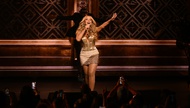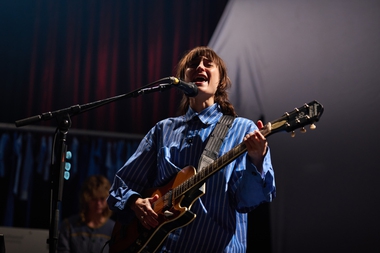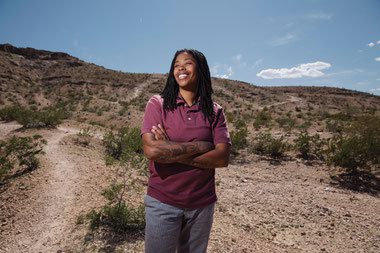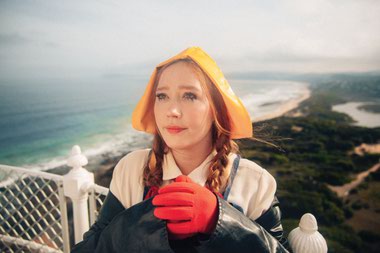The traffic of Las Vegas’ stages has varied wildly over the years, from showgirl revues to Broadway shows to neo-circus spectaculars. The music changes, as does the scenery, the choreography—virtually everything but the need for costumes that are dazzling enough to read at a distance. Amanda Williams, a Reno native who moved here in 2017 by way of the Bay Area, is maintaining that tradition with her costume work for Le Rêve, Opium and Westgate headliner Barry Manilow. She recently took a moment to tell the Weekly how Vegas feeds her creativity.
How do you describe your profession to people? I say I’m a costumer, as an umbrella term for a little bit of everything. If somebody wants alterations, I can do that; if somebody needs something designed, I can do that. If somebody needs me to re-create something that was falling apart … I mean, I can do just about everything as long as there’s thread and a sewing machine and scissors involved.
How did you get your start? I always wanted to be a fashion designer. I went to school in San Francisco, but then once it came time find work in fashion, San Francisco doesn’t have the same industry as LA or New York, so I had to take whatever job was similar. I took on an internship at a historical dance company called Dance Through Time, which performed dances from the medieval period through contemporary hip-hop. They had costumes that paired with each dance, and they needed a wardrobe mistress, so I applied and I got it.
I worked with them for about five years; we toured all over the country. I just wound up in that industry, and I kept on going. I continued to sew and design and do wardrobe management for almost every Bay Area theater and dance company.
What brought you to Vegas? It was time for a change. I’d lived in San Francisco and the Bay Area at large for 25 years, and it was getting expensive. … Just by chance, I ended up meeting somebody who knew the costume shop manager for Le Rêve. I contacted her asking about a costume tech position and they happened to have one open, so I flew down, interviewed and I just got it.
Next thing you know, you’re making a jacket for Barry Manilow. Yeah! I mean, if you’d told me a year or two prior that I’d be working with Barry Manilow—meeting him in his dressing room to do a fitting on a jacket—I’d be like, “No, you’re high.” But that’s exactly what happened. I think it was meant to be, for me to come down here and work in this industry. It’s just been so much fun, offering me a lot of opportunities I never would have had otherwise.
How much inspiration do you take from Vegas’ costuming legacy—the showgirls, the Strip headliners? Well, before this I’d never attended a show in Vegas, or in Reno for that matter. So when I heard that they were doing a display of the Jubilee! showgirl costumes at Nevada State Museum, and then seeing those Bob Mackie and Pete Menefee designs up close … that really told me a lot of stories about the costumes. Because you get to learn about how they actually constructed them for quick changes and for ease of movement, and you see a little bit of wear and tear. That’s basically why I was hired, because costumes go through a lot of wear and tear, and you have to keep making them over and over and over.
And then you’re really struck by how many rhinestones are all over the place—to the point where costumes were so heavy that they had to use leaning boards for the gals between scenes, because they couldn’t sit down in them, could barely walk around in them.
A lot of people don’t realize these little tricks of the trade. They’re just in the audience being mesmerized by all of the colors and the jewels, but there’s a lot going on behind the scenes. And that’s what I like.
Do you go to a lot of Strip shows? I try to see as many shows as I can, which I’m learning that most locals don’t do. I’m really surprised by that.
When you’re looking at a costume by someone of Bob Mackie’s caliber, what is the first thing that jumps out at you? What about the work says, this was done by a master? It’s definitely in the patterning. You’ll see where the seams are, where you would normally see something standardly made—and when you go and look at a master and you’re like, “Why is that seam there, and why did they choose to put the collar that way?” You notice that there’s an anomaly to the construction of the garment, and you come to find out that there was some reason for it, or he had knowledge of that fabric. Like [fashion designer] Issey Miyake, they have some extra knowledge of the fabric and how it’s going to hang, flow and take up space. That is taking it to another level. They’re doing this in their head, and it’s almost like origami or architecture.
What parts of your process do you most and least enjoy? My favorite part of the process is coming up with ideas and finding the supplies, the fabrics and the threads, and going shopping for the stuff, all the colors. That’s the design side of me: “Ooh, what if we use this, and what if we have this trim and this button?” I love going to choose buttons for a jacket. Unfortunately, there’s not a lot of fabric stores here. In San Francisco, I would go to Britex, where they had an entire room full of just fabulous buttons. I could just spend the whole day looking through buttons.
My least favorite part is probably towards the end of putting the garment together, where it’s not the creative work. It’s, “OK, I have to finish the seam so it doesn’t unravel; I have to do the hand-sewing.” At that point, you’re getting really impatient. It starts out wonderful and you have all these ideas, and in the end you’re like, “OK, I just need to get this thing done.”
I didn’t realize Vegas is a fabric store, er, desert. Literally! Literally! When I moved here, I thought, “Oh, there’s got to be fabric stores everywhere for all the shows, right?” And I was stunned to find out there was only, you know, your Joann’s, which is a chain store that’s everywhere, and it doesn’t have a lot of the kind of things that a professional would need. And then there’s Heddy’s, which has a little bit more stuff than Joann’s, but it’s also very expensive, because they’re the only game in town. You have to go to LA if you want to get the fancy stuff. As soon as I get a new project, I’m like, “OK, I’m going to make a trip to Los Angeles to go shopping for a day or two.”
You know, fabric stores have been going out of business all over the country. It’s not just here. They’ve been closing down in San Francisco, too, because people just don’t sew as much anymore. I mean, people do sew, there’s stuff that people are selling on Etsy … but fabric stores are just not able to stay open, so it’s all getting centralized to New York and Los Angeles, unfortunately.
What do you do in Vegas to get inspiration? The art exhibits. I really loved going to Bellagio and seeing Yayoi Kusama’s infinity room. I like to go Downtown and look at the neon; it’s still novel to me. I mean, I had it in Reno, but here it’s more lauded and appreciated. Also, all the murals around downtown, which are really beautiful. And I like the quirky architecture here in Vegas, all the midcentury stuff. Also the weird Frank Gehry building [the Cleveland Clinic Lou Ruvo Center for Brain Health] and Guardian Angel Cathedral.
I’m a city girl, so anywhere I can go, there’s a lot of hustle and bustle. I like to people-watch. Locals don’t like going on the strip, but I don’t mind it at all. I like the visual simulation.
Finally, what do you think Vegas most needs, and what is it best at providing? It needs [a stand-alone] art museum. There are art galleries, but it’s not like a major metropolitan city’s museum of modern art—an institution like the kind that I’m used to, that has a rotating exhibit. That’s something that I really wish it had. But what it does have is so much space, constantly sunny weather and stuff that’s always new, because it’s still a new city. You’ve just got to be patient, because sooner or later, what you need is going to show up.








